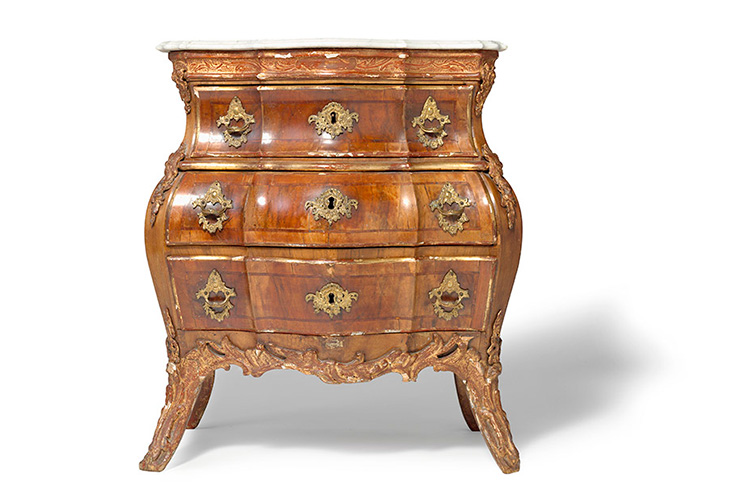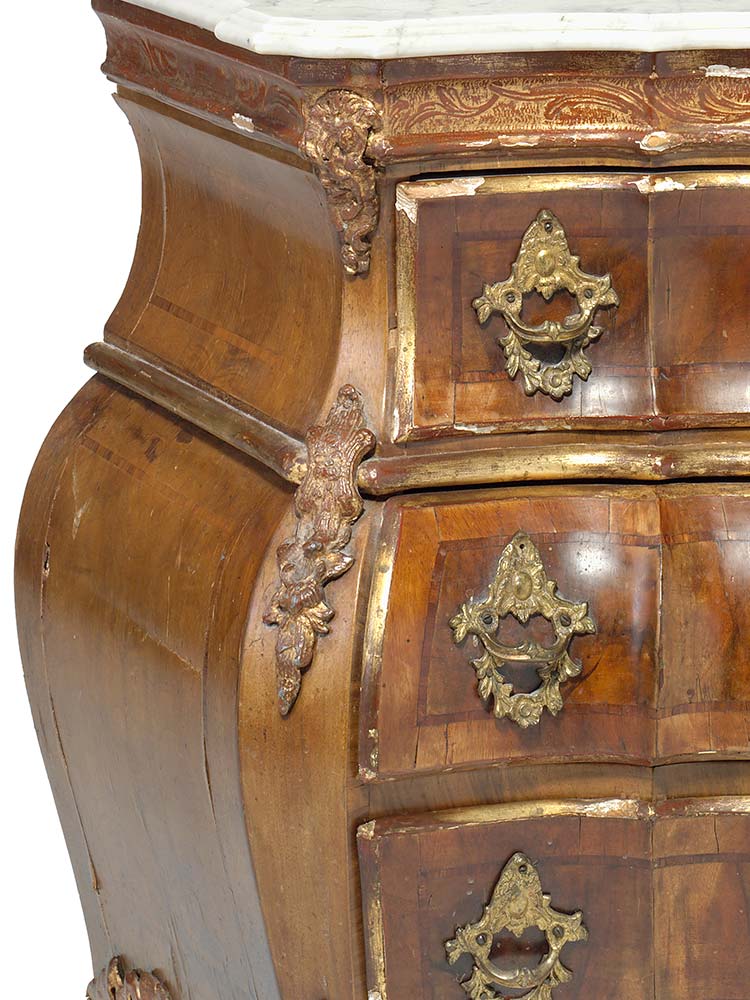
Mathias Ortmann: Signed Commode by the Master Himself
A unique commode created by Danish King Christian VI's favourite art- and cabinetmaker, Mathias Ortmann, is now up for auction in Copenhagen. If you have antiques that you wish to sell at the same auction, you still have time to consign them. The final deadline is Thursday 30 April.
This summer's Live Auction in June includes a commode from the mid-1700s by the famous Danish cabinetmaker Mathias Ortmann (1692-1757). The bombé-shaped commode is made of walnut and giltwood with the finest organic carvings. Fittings and handles are of gilt-bronze and -lead, while the top is made of the precious Cararra marble from Northern Italy. Few Danish furniture pieces from the 18th century come with a signature by their maker, but this is precisely the case with the offered commode. On an engraved label one can read the following signature and inscription as proof of the origin: "At Sr M. Orthmann, living in Gotters Gaden, all sorts of cabinet and carpentry work is done for a civil price in Copenhagen" (translated from Danish).
Guarantee of a Genuine Ortmann
|
Ortmann's furniture pieces are of an exceptional quality and represent the finest within the Northern European Rococo style. What sets Ortmann apart from other contemporary cabinetmakers, however, is his habit of signing his furniture. Ortmann's name has in this way been immortalized for posterity, and his furniture has become increasingly sought-after, yet rarely offered, collectors' items. It was on a Grand Tour around Europe, mainly to Louis XV's France, that Ortmann experienced the benefit of signing his furniture. The label is today the collector's guarantee of "a genuine Ortmann". However, not all Ortmann furniture carries the coveted signature – he only used it in the period 1745-1757. |

|
Outstanding Furniture Art

|
|
Ortmann was born in Sweden as the son of a cabinetmaker. The family moved to Copenhagen to open a workshop in the Nyhavn area. Early on, Ortmann became an apprentice in his father's workshop, which produced furniture for Frederik IV's brother Prince Carl's "Charlottenborg" Palace. Ortmann's mother continued the workshop after the father's death in 1723. Two years later Ortmann passed his final test, and in 1727 he obtained citizenship as a cabinetmaker. When it comes to commodes, a characteristic element of Ortmann's style is the inspiration he found on his travels to France, but the style is not entirely French. The furniture has local features added that are only known from Schleswig-Holstein and Denmark. Where French furniture is often made from exotic wood materials, Ortmann mainly used walnut imported from Italy. Another distinctive feature in his style is the corner ornaments of gilt-lead – it was far more common, among other cabinetmakers of the time, to use giltwood carvings or bronze fittings for the corner ornaments of the furniture. Among the typical characteristics of Ortmann's commode are also the giltwood edges on the drawers and the plaster frieze under the edge of the top, which does not appear on, for instance, French furniture. |
Consignment to the Live Auction in Copenhagen
If you are considering an auction sale for some of your antiques, you can still consign them to this summer's auction until Thursday 30 April. You can either use our online valuation service or come by one of our local offices in Aarhus and Copenhagen. Read about the precautions we have taken in connection with COVID-19.

Want a free valuation?
For further information, please contact:
Henrik Schleppegrel: +45 8818 1145 · hsc@bruun-rasmussen.dk
Anders Fredsted: +45 8818 1142 · afr@bruun-rasmussen.dk